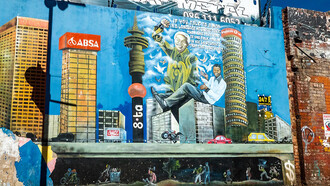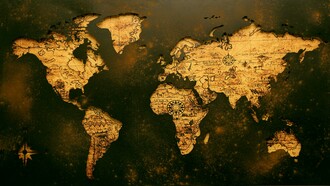History repeats itself, first as tragedy, second as farce.
(Karl Marx, The Eighteenth Brumaire of Louis Napoleon)
The average, concerned citizen with access to email is similar in a way to their peers who lived in the 1930s and 1940s, when Russia was still an important ally in the struggle to win the world against German fascism. Practically at the drop of a hat, those who sympathized with Russia were ostracized. As many youth signed, and formed countless petitions in the 1930s, when social consciousness and progressive activism were commonly shared values, so petitions, protests and declarations are concurred through current trends of online “clicktivism”.
In the second decade of the 2000s, the NSA, like the bygone HUAC, became infamously exposed for surveying such meta-data with an indiscriminate watch. Indeed, there are very clear and direct connections that can be made to the techniques of McCarthyism, as to the ambiguities of subversion, with the exposure of the contemporary surveillance culture in America.
Watch lists may not have been part of Americans’ daily vocabulary prior to Sept. 11, 2001, but they have actually existed for years — including most notably during the “Red Scare” of the 1950s. The main difference between watch lists of yesteryear and the current Terrorist Watchlist is that before 9/11, law enforcement agencies had their own watch lists and didn’t necessarily share who they were monitoring with other agencies (Rucke, 2014).
More, as heavy-handed techniques of surveillance spotlight religious, and political minorities, such as socially active Muslim-American citizens, they become entrapped, and find themselves on terrorist watch lists. Of all of the prosecuted terrorism charges in the U.S., Human Rights Watch recently confirmed through their reportage that almost half of them were the result of government intervention.
As noted in their 214 page report, “Illusions of Justice: Human Rights Abuses in US Terrorism Prosecutions”, prepared together with the Columbia Law School Human Rights Institute, “According to multiple studies, nearly 50 percent of the more than 500 federal counterterrorism convictions resulted from informant-based cases; almost 30 percent of those cases were sting operations in which the informant played an active role in the underlying plot” (Human Rights Watch, 2014).
Strikingly, the struggle to maintain the rights of the First Amendment to the U.S. Constitution is continually obstructed by the very foundations of justice that created them. Equally as free speech is a concern, so the freedom of the press is another First Amendment right at the center of concern. Essentially, the narratives of child migrants run parallel to the greater story of local exposure to the expansive significance of free and diverse interaction with the rest of the world, as within varying sectors of society domestically.
One of the most tried and true public methods for this intercourse is in the common good of independent journalism. Following the debate on immigration, a complimentary report issued by Human Rights Watch, titled “With Liberty To Monitor All: How Large-Scale US Surveillance is Harming Journalism, Law, and American Democracy” interviewed 50 journalists who cover intelligence, national security, and law enforcement from such reputable publications as the Associated Press, NPR, and the New York Times, among many others (Human Rights Watch, 2014).
‘What makes government better is our work exposing information,’ argued Dana Priest, a Pulitzer Prize-winning national security reporter at the Washington Post. ‘It’s not just that it’s harder for me to do my job, though it is. It also makes the country less safe. Institutions work less well, and it increases the risk of corruption. Secrecy works against all of us’ (Human Rights Watch, 2014).
In 120 pages, the report, “With Liberty To Monitor All” presented as strong a case as any from an impressive number of utterly reputable voices representing the strongholds of American media. The freedom of the press, as with the related struggle to uphold the freedom of speech, is intimately linked to the present state of national security, and to the means, and style, by which the present crisis of child migrants is confronted, and resolved, as pertains to the humanitarian context.
In the example of child migrants, however, national security is marginally relevant. Throughout America’s lifespan as a modern nation state, there may never be an enduring appeasement of the invasion mentality, as presently spouted against child migrants from the cruel, and unfounded politically motivated rhetoric from the extreme right. In which case, a self-reflexive consideration of immigration policy is required in order to move forward with empathy for the immediacy of the international crisis at hand.
A Portrait of the Artist as an Immigrant
The artist portrayed began her life in Vietnam (her name will remain unpublicized with respect to the sensitivity of her precarious status as a foreigner). Her mother, impoverished, and widowed, survived the streets of Saigon before emigrating. One day, a shell from an American bomb crashed through the roof of her brother’s attic, where she stayed as a recent migrant from Cambodia. Only once again in her life in Southeast Asia would she endure such an abrupt upheaval, the day her husband died unexpectedly, when she was thrown out of the home of her married family.
As the uneducated, fifteenth daughter of a Cambodian migrant family, her life in a Vietnamese-Chinese family was fortunate. The intensity of this uprooting with her daughters aged eight and nine would not resurface in her life again until the day she left her country. Her eldest daughter grew to become a nurse, and later led her abroad. Before leaving, she found an orphaned child in the restroom floor of her hospital. At five years of age, that child accompanied her new family to North America. Now, she tells her story, from New York City, where she is forced to “visit” her husband, for six months at a time. What follows is a verbatim interview with the artist:
My very last memories of Vietnam were of my excitement to board the jumbo jet with my mom and my sister. We were sent off by all of our friends and relatives. I remember the night before the flight, a grand feast at a large restaurant with all of our friends and family. I remember saying goodbye to my blind cat, and her kitten. The next thing I knew I was on board the flight to Calgary, Alberta. We were sponsored by my eldest sister, who had come over to Calgary a few years before, and was a boat person. She came over in 1980, and we immigrated in 1983.
I am the youngest, and so being the youngest, naturally my mother wanted the best for me, despite her being a widow, single parent, and struggling completely to make ends meet. [In Vietnam] her and my sister sewed ball caps for American sports companies, for instance, Reebok, Adidas. She had to basically beg this neighbor who was connected to the factory, a recruiter. My mother, and my sister had to beg the recruiter to give them work.
So, the recruiter said, “I could give you work, but you’re going to make a lot less than everyone else. Since you’re working from home, and you’re still raising your youngest child.” I would have been one, going on two then. My mom would be on an old-fashioned pedal-style sewing machine, sewing hundreds of ball caps, and sports accessories, hundreds of pieces in an hour with my second eldest sister, and earning under fifty cents, or under a dollar a week.
They could only afford a handful of rice, a handful of salt, a handful of meat, and maybe produce. So she raised me on sweetened condensed milk with boiled water as my milk formula, and basically rotted my teeth, and I was malnourished. She recalls me playing with the neighbors and often found me fainted at the doorstep as I was knocking on the door to be let in. I fainted in the humidity of the season. I was a very weak child, but I was very outspoken and very well liked in the neighborhood. That’s obviously a lot of struggle and strife for my mom. She was never able to live a life for herself. She always lived for her children, and that’s what I am always reminded of, and that’s what I always carry heavily in my heart. I owe it to my mom to make a better life for myself.
References
Katie Rucke. (July 23, 2014). Startling’ Number of Americans Are On Terrorist Watchlist. MintPress News
Human Rights Watch. (2014). Illusions of Justice: Human Rights Abuses in US Terrorism Prosecutions
Human Rights Watch. (July 28, 2014). US: Surveillance Harming Journalism, Law, Democracy
Human Rights Watch. (2014). With Liberty To Monitor All: How Large-Scale US Surveillance is Harming Journalism, Law and American Democracy. p. 45















